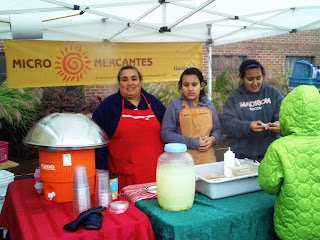When I asked Micaela about what strategies she has found to be most effective in helping women, the first thing she said was getting them out of isolation and into community with other women; in this way they realize that they aren’t the only ones facing their struggles. She said that even if nothing on the outside changes and circumstances remain the same, these women will still be stronger because they aren’t alone. Our partner organizations embodied this strategy: Mujeres y Maíz and Siempre Viva are both collectives- meaning groups of women who support each other relationally and in their business work and at the same time utilize their skills and knowledge (this could include traditional skills they learned within the culture, like making tortillas, or a skill set from outside education, perhaps by an NGO).
What Micaela said about the collective resonated more strongly with me after spending the previous two weeks working with the other students on the mantas (these were essentially banners for the women to hang on their stands at the markets that include their contact information and what products they make) for Mujeres y Maíz than it could have before that experience. On a small scale, I got a taste of what this collective process looks like. Andrew said it well in our final presentation when he said he used to think of art as an individual act, but after the manta experience, he saw art transformed into a group collaboration process. At any given moment during the creation of the 8 mantas, different people were designing, sketching images, and painting- based on what skills they had. For example, I sketched out the stencils for “Mujeres y Maíz” based on the Papyrus font, and Andrew cut them out using an Xacto knife. Meanwhile, Angie was sketching out the design of the mantas in pencil and Andrea was going over the pencil with paint.
Micaela said she has seen collectives transform the lives of women. She classifies them as one of the two currents of women’s groups in Chiapas: the kinds that are creating a different way of doing things. (The other current she classifies as those that are fighting against something, like the feminist groups that are struggling against the capitalist system that pits men and women against each other.) Our conversation reiterated the importance of what our community partners are accomplishing in Chiapas- even if it may seem like a simple idea to outsiders.
Looking at the future of women and development in Chiapas, I think it’s important to remember that small works. It’s easy for me to equate the size of an NGO with its level of effectiveness, but the beauty of the collective isn’t in its size. When Micaela was talking about collectives, she compared them to ants. The idea is that gradually (she kept saying this: “poco a poco”), with lots of people involved wherever they can be, change will happen. She made it clear that this won’t be easy. A change in the mentality and culture of Chiapas, and many other parts of the world, still needs to happen for women to have their rights. (And let me be clear, by “rights” I don’t just mean things like the right to vote, but also things like the right not to be beaten by their husbands.) She echoed what another speaker from the government had told us, that the men in the Mexican government are the first people who need to be educated on women’s rights. Legally, Mexican women have lots of rights, but they aren’t being enforced; continued resistance to women being in leadership positions means that it is up to men to implement the laws.
But this situation is hardly surprising given how recent positive changes have been occurring for women. Micaela called 2000 the year of change for women in Chiapas- just a decade ago! After seeing the strength of the women and their great ability to organize themselves, and also learning about the desperate situation they face, I left Chiapas with the sense of the great, enduring struggle they face. Yet the women I met left me convinced that Chiapas will see change, poco a poco.
Women in Chiapas need outside support as well! Here are links to some of the amazing NGOs we met during our time in Mexico:


 for more photos of Acteal, view our
for more photos of Acteal, view our 






